How To Secure a TV (to a Table) To Prevent It From Tipping Over
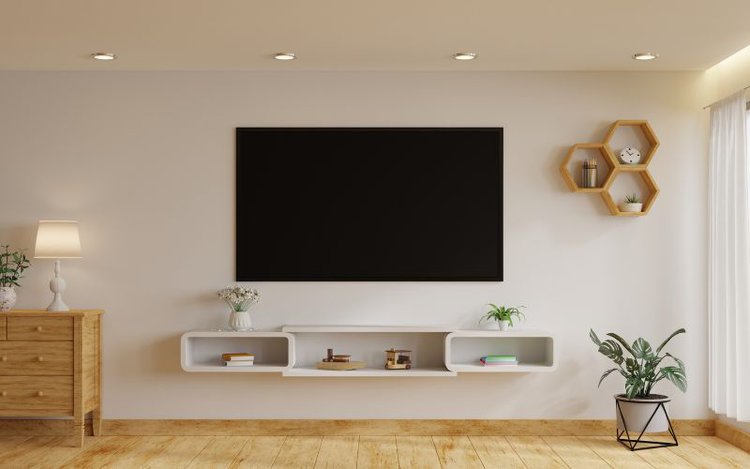
What To Know
- Mounting your TV on the wall is a proven and safe solution to prevent it from falling and causing injuries or damage.
- Using TV safety straps or a bolt-down TV stand can effectively secure your TV to furniture, minimizing the risk of tipping.
- Placing the TV stand close to the wall or using heavy-duty self-adhesive strips are simple yet effective methods to stabilize your TV and prevent accidents.
In this article, I’ll share 5 effective solutions to secure your TV to a table and prevent it from tipping over, addressing the serious issue of TV-related accidents and damages.
Let’s explore how to protect your TV effectively!
Quick Navigation
1. Mount the TV on the Wall
The 2021 Consumer Product Safety Commission report on tip-over injuries shows that between the years 2018 and 2020, injuries involving TVs accounted for 16% of all emergency-treated cases.
More distressing is finding out that 184 fatalities reported between 2000 and 2020 were caused by falling TVs.
It is terrifying to know that these aren’t random figures but that someone in your household or someone you know could be part of these statistics.
To prevent any mishappenings, consider mounting your TV on the wall. It is one of the safest ways to keep the appliance from falling and is a proven solution to preventing such accidents.
How To Mount a TV
Follow these steps to wall-mount your TV.
1. Buy a TV mount that’s appropriate for your TV
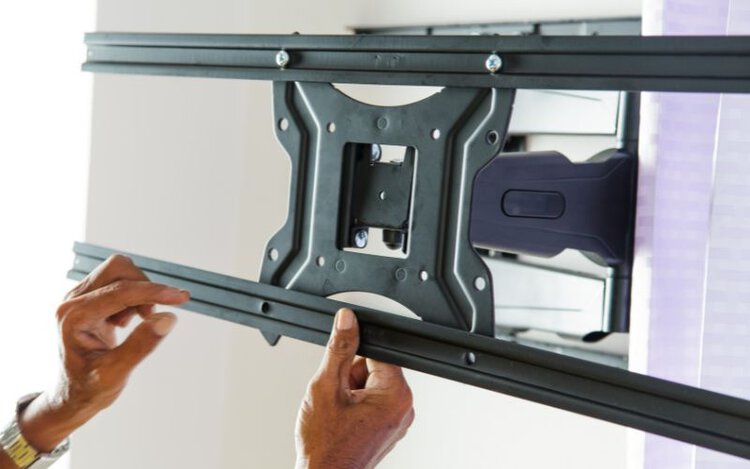
Each TV mount is made for a specific TV size and weight range. Ensure that the TV mount you choose matches the size and weight of your TV.
The easiest way to find the right mounting kit is by looking up your TV’s VESA standard.
You can find this information in the TV manual. If you can’t find your manual, search for the digital version of the manual on your TV manufacturer’s website.
Note the VESA standard that applies to your TV, then search for a TV mount that matches this standard.
TV mounts come with all the hardware needed to mount the TV. Therefore, you won’t be buying any extra mounting accessories.
2. Decide how high you want to mount the TV
There is no consensus on how high up the wall your TV should be, and Sony says mounting height depends on personal preference and seating arrangement.
An ideal height would be one where the shortest members of the family don’t have to crane their necks to see the TV screen.
3. Mark where the TV should go on the wall
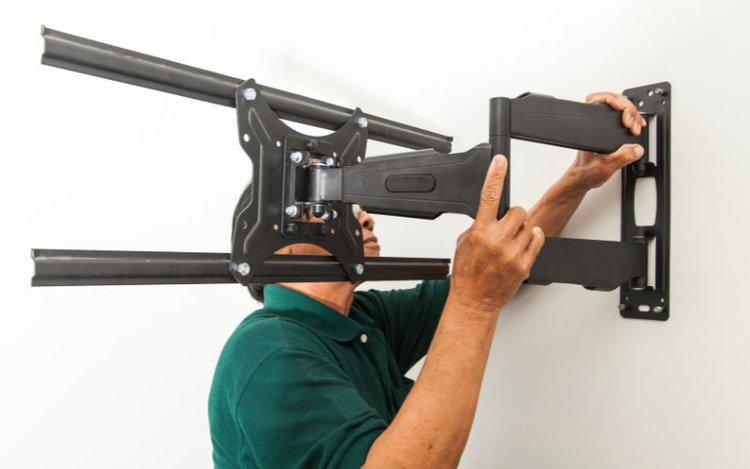
Take the wall bracket (from the mount you bought) and place it against the wall. Align your pilot hole marks with the bracket’s mounting holes. Use a level to ensure that the marks are even.
If working on drywall, ensure that the pilot holes are on studs, not the drywall itself. Studs provide the extra support that drywall needs to hold the weight of a TV
4. Drill pilot holes in the locations you’ve marked
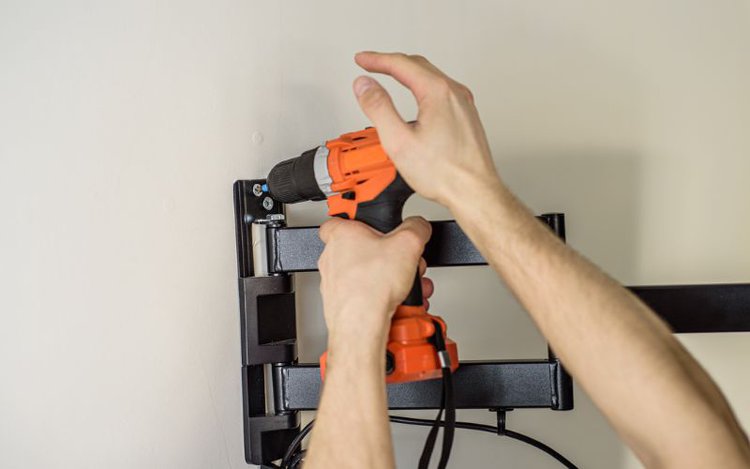
5. Attach the mounting plate to the TV
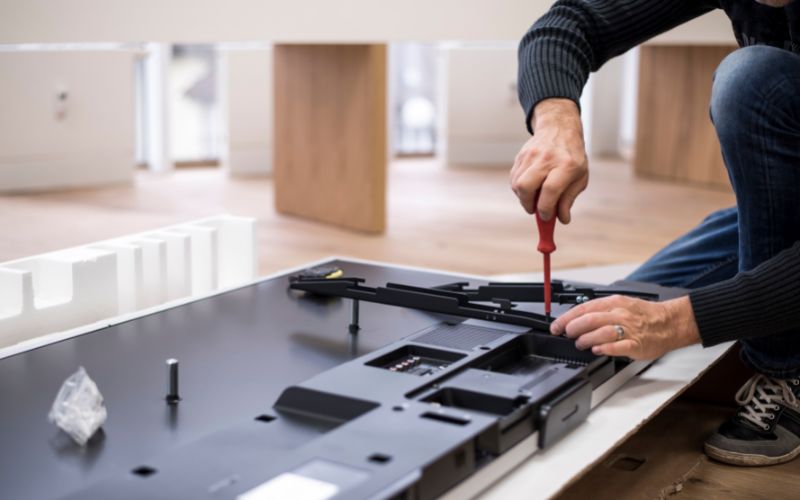
Each mount comes with assembly instructions. Follow the given instructions on how to attach the plate to your TV.
6. Attach the mounting bracket to the wall
Position the wall bracket on the wall, then drive the screws provided into the pilot holes.
Tighten the screws until the bracket is snugly held in place and doesn’t wiggle around.
7. Mount the TV to the wall bracket
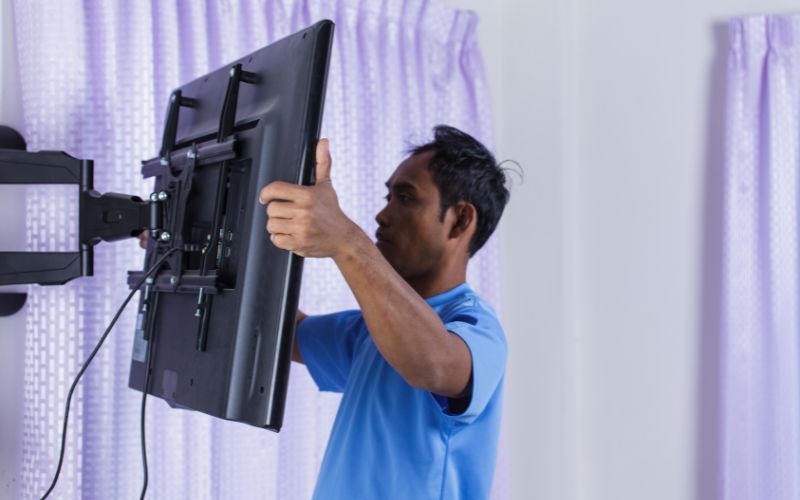
For this step, consider getting a second pair of hands to help you, especially if your TV is large and heavy.
Together, lift the TV and attach the mounting plate to the wall bracket.
Usually, the wall bracket and mounting plate connect through a built-in connector or an attachment.
Once you slide the mounting plate against the wall bracket, screw or clip the connector/attachment into place. Then add and tighten any safety screws provided.
The exact procedure for joining the two plates may be different for each mounting kit, so follow the steps outlined in your user guide.
Here’s a great video tutorial to guide you better.
Tips
#1: Huge TVs can be too bulky and heavy for one person to lift. If your TV is big, you may need help lifting it.
#2: You don’t have to mount the TV yourself. If it’s too tasking, hire a technician to help you.
2. Attach TV Straps to the Top and Bottom of the TV
TV safety straps are designed to keep the TV from tipping forward.
- Universal furniture straps
- Straps work in 4 different configurations: Secure your TV to the Wall, Secure your TV to your...
- 53" Long
(Paid Link.)
The straps hold back the TV so that if something or someone tries to knock it over, it won’t fall backward.
You can also ensure that the TV doesn’t fall over the TV cabinet by attaching the straps to the cabinet and then to the wall.
You will use two pairs of straps to attach to the wall:
- One on the same level as the top of the TV
- One slightly below the bottom of the TV
With this setup, If someone tips the TV cabinet in a manner that both the cabinet and the TV lean back, the straps will hold the TV in place.
How to attach the straps
Most TVs come with four mounting holes: two near the top and two near the bottom.
Two of the safety straps will go into the holes near the top of the TV, and the other two will go into the lower mounting holes.
TV safety straps come complete with all the installation hardware and instructions.
The installation procedure may differ from one brand to the next. So follow the instructions included in the strap kit you buy.
But generally, you’ll attach the ends of the straps to the TV’s mounting holes using screws.
Next, attach the bracket to the wall. If you have drywall, ensure that the bracket goes into a stud.
The drywall alone isn’t sturdy enough to support the TV, so you can’t use it. But you can use a drywall fastener if the TV strap manufacturer recommends it.
Drill two holes in the TV stand, pull the straps attached to the TV toward the holes, and fasten them to the holes using screws.
Tie the ends of the straps to the wall bracket and pull tight.
Fasten one end of the remaining straps to the upper TV mounting holes.
Attach a wall bracket, keeping it on the same level as the TV or slightly below it.
If you’re not worried about the straps being visible from across the room, you can install the bracket above the TV.
Attach the ends of the straps to the bracket and pull tight.
3. Use a Bolt-Down TV Stand
Secure the TV with a bolt-down TV stand, and you won’t have to worry about it tipping in any direction.
- Bolt-Down TV Stand secures to your dresser, desk, or other surfaces to provide solid support for...
- Swivel Adjustment ranging from -30° to +30° allows proper positioning for a comfortable viewing...
- Solid Steel Construction supports 32” to 55” TV screens weighing up to 110 pounds and is...
(Paid Link.)
Bolt-down TV stands come with mounting brackets for the TV. So you mount the TV on the stand and then attach the TV stand to the furniture the TV is on.
Most bolt-down TV stands come with the necessary installation hardware.
How to install the stand
Fasten the bolt-down stand onto the tabletop using the provided screws and washers.
Attach the mounting bracket to the TV, then attach the TV to the stand.
The process may slightly differ for each TV. Be sure to follow the installation instructions in your TV stand manual.
4. Place the TV Stand Next to the Wall
This is an easy solution because it doesn’t require extra equipment or special skills.
Place the TV stand as close to the wall as possible. This helps because if the TV tips backward, it can’t fall into the space between the furniture and the wall.
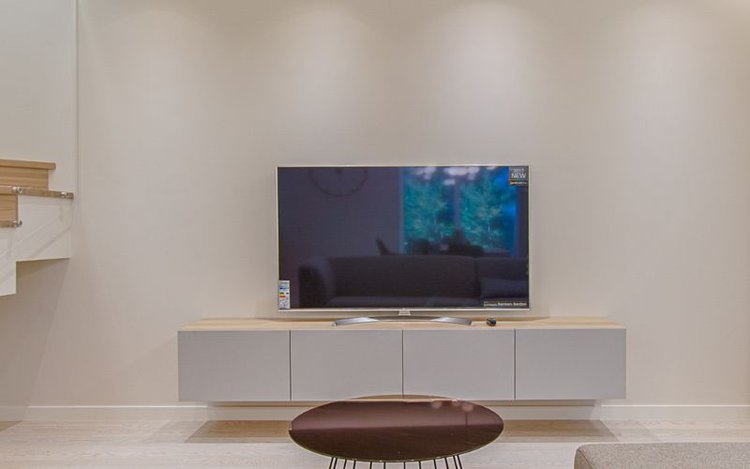
You can add TV straps to the back of the TV to protect it from playful little hands. If a child climbs atop the TV stand and tries to move it, they wouldn’t be able to dislodge it.
Without the straps, the TV can still tip forward. So it’s strongly advisable to attach the straps as an added security measure.
Tips
#1: Ensure that the TV stand is wider than the TV. It should also be stable and sturdy so that a child can’t knock it over.
#2: Position the TV as far back on the furniture as possible. As long as the cabinet/stand is well-made, placing the TV at the farthest end should not affect its stability.
5. Tape It Down with TV Self-Adhesive Strips
You can use heavy-duty self-adhesive strips or tape to secure the TV to a cabinet.
Choose self-adhesive tape made for TVs or use other equally hardy tape approved for use on TVs by the manufacturer.
How to use
Most of these are easy to use, you just peel it and stick it to a surface. Then place the TV on top.
Each brand comes with user instructions, so follow the outlined recommendations keenly.
When used the right way, the best TV strips offer just as much grip as any worthy fastener.
Tip
These TV strips can lose their grip when exposed to heat. So you want to make sure you keep them away from hot environments.
Meet Vance. He’s a proud dad, a seasoned Electronics Engineer, and an avid tech lover. His proficiency in electronics and troubleshooting skills were instrumental in crafting Pointer Clicker. Vance is passionate about simplifying tech for those who aren’t well-versed in it.




buenas tardes una consulta
compre un soporte para el tv
pero al instalarlo me encuentro que la tornilleria y los orificois donde se deben colocar no casan, los empaque van en el orificio y luego los tornillos si es seguro que no se ciga el tv. es seguro o me regala una guia claro y consisa, muchas gracias por atenderme. y por la respuesta quedo muy muy agradecido. buen dia. abrazos y bendiciones.